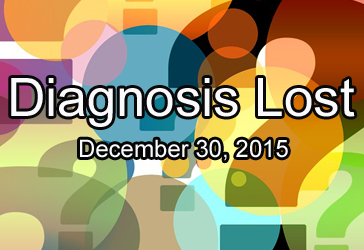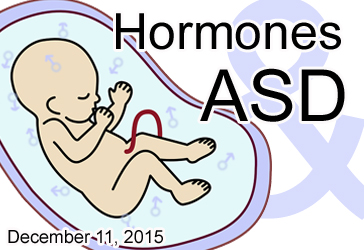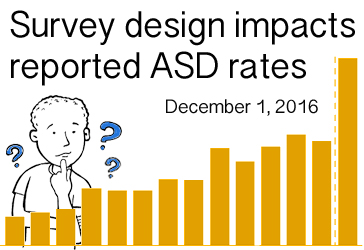Archives
December, 2015
Select a different month in the archive
Lost Diagnoses May Affect Autism Prevalence Estimates
By Chelsea E. Toledo, M.A. on December 30, 2015

Background: The U.S. Centers for Disease Control and Prevention estimates that 1 in 68 American children has autism spectrum disorder (ASD), a number based on nation-wide surveys and the review of medical and/or educational records. When public health professionals update survey design, the estimated autism prevalence often shifts to a different number. The actual prevalence is less defined than it may seem.
What’s New: On October 20, 2015, the journal Autism published a study exploring the possibility that estimates of ASD’s prevalence may be influenced by “lost diagnoses” – meaning that experts count children who previously had a diagnosis for autism that was later reconsidered. The researchers compared national survey data and retrospective parental interviews from 1420 children between the ages of 6 and 17 with ASD against those from 187 of their peers who had lost their diagnoses.
They found that about one in eight children ever diagnosed with ASD eventually lost the diagnosis, and that three-fourths of those diagnoses changed based on new information from doctors. According to the parental interviews, other reasons included:
- Initial diagnosis of ASD enabled the child to receive needed services, but the child never had ASD
- Treatment helped the condition go away
- Misdiagnosed after not testing properly
- Disagreement with the doctor’s diagnosis
Children with lost diagnoses were less likely to have parents concerned early on about their communication, behavior and social abilities, and were also less likely to have received their initial diagnosis from an ASD specialist.
Why it’s important: This study highlights the imprecise nature of autism estimates by pointing out several reasons for a lost ASD diagnosis. Future research could determine whether diagnoses made by non-specialists are overinflating the estimates of ASD prevalence.
Help me understand :
| Source(s) : |
| Tweet |
Hormone Disorder in Mom Increases ASD Risk in Child
By Shana R. Spindler, Ph.D. on December 11, 2015

Background: Given the increasing recognition of autism spectrum disorder (ASD) in the last decade, researchers are investigating its biological causes with intense scrutiny. One line of research suggests that excess male sex hormones in the womb may affect brain development in the baby—creating what some term “extreme male brain.” Previous hormone studies, however, have been small in scale, and their findings have been inconsistent.
What’s new: On December 8, 2015, the journal Molecular Psychiatry published a study examining the role of hormone imbalance during pregnancy in ASD risk. The researchers examined Swedish medical records of 23,748 children with ASD aged 4 to 17 years and 208,796 matched controls. They found that women diagnosed with polycystic ovarian syndrome (PCOS)—a disorder in which the ovaries produce too much of the male sex hormone called androgen—are 59 percent more likely than women without PCOS to have a child with ASD.
Why it’s important: This study supports the need to further examine the role that hormone imbalance during pregnancy plays in ASD risk. Based on this study alone, we cannot determine if PCOS in the mother increases ASD risk due to hormone exposure in the womb or because common genetic pathways influence the development of both PCOS and ASD.
Help me understand :
| Source(s) : |
| Tweet |
Survey Redesign Raises ASD Prevalence Estimate
By Shana R. Spindler, Ph.D. on December 1, 2015

Background: The National Health Interview Survey (NHIS) is a national, parent-reported household survey, which includes questions about lifetime autism spectrum disorder (ASD) diagnosis. For several years, the NHIS reported a lower rate of ASD in the United States compared to other major surveys at the time. To what extent survey design, wording, and presentation affect the reporting of ASD diagnosis is an important area of investigation.
What’s new: Survey question wording and order have a significant impact on report rates for ASD, according to a new National Health Statistics Report. Researchers compared the ASD rate between the 2011-2013 NHIS and the 2014 NHIS, which included several changes in questions related to ASD. The 2014 survey included a stand-alone question about ASD diagnosis placed before questions about other developmental disabilities, and the survey language included terminology such as autism, Asperger’s disorder, and pervasive developmental disorder. With these changes, the reported ASD rate climbed from 1 in 80 to 1 in 45 for children ages 3 to 17 years. The 2014 survey included approximately 13,000 participants.
Why it’s important: This study highlights the importance of survey design for accurate estimates of ASD prevalence. Based on the short time period between the 2011-2013 and 2014 surveys, the authors state that an environmental factor is unlikely to have caused the dramatic increase in ASD prevalence between the two surveys.
Help me understand :
| Source(s) : |
| Tweet |

